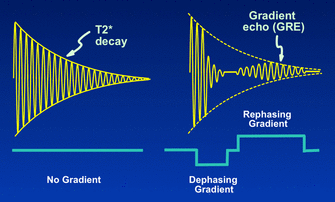Each RF-pulse generates a free induction decay (FID) signal immediately after it is applied. The FID decays with time constant T2* that reflects both natural/true/intrinsic T2-relaxation plus accelerated signal loss due to magnetic field inhomogeneities.
Each pair of RF-pulses generates a spin echo (SE), that because of regular spacing of the RF-pulse train, forms and rises to a maximum exactly a the time of the next RF-pulse. Each set of three RF-pulses also generate stimulated echoes (STEs) that coincide with the spin echoes. The "Echo" portion of the GRE sequence is mostly T2-weighted with fewer T2* effects.
Each pair of RF-pulses generates a spin echo (SE), that because of regular spacing of the RF-pulse train, forms and rises to a maximum exactly a the time of the next RF-pulse. Each set of three RF-pulses also generate stimulated echoes (STEs) that coincide with the spin echoes. The "Echo" portion of the GRE sequence is mostly T2-weighted with fewer T2* effects.
After many RF-pulses the two signal components reach a steady-state and begin to lose their original identities as discrete FIDs and SE/STEs. In fact, both result from the summation of echoes and magnetization created from multiple prior cycles For this reason some authors prefer to denote them as S+ and S-, or use more generic terms such as "post-excitation" and "pre-excitation" signals, respectively. For the purposes of this web site I will stay with the older nomenclature, continuing to refer to them as "FIDs" and "Echoes". Perhaps "FID-like" and "Echo-like" would be more appropriate.
|
An interesting phenomenon occurs within an RF-pulse train if TR is made much shorter than T2. Here the "FID" following each RF-pulse does not completely die out before the "Echo" component begins to form. In this situation the transverse signal never completely disappears and the result is called a steady-state free precession (SSFP).
|
|
Either of the signals generated by the RF-pulse train ("FIDs" or "Echoes") can be temporarily suppressed and then made to reappear at a chosen time (TE) by application of an external magnetic gradient field. The gradient is typically applied in two steps: 1) a dephase portion that forces spins out of phase, and 2) a rephase portion that brings them back into phase as the GRE.
|
By changing the timing, strength, and duration of the gradients it is possible to refocus either the "FID", the "Echo", or both at a specified times as the GRE. This is possible because the dephasing gradient field simply "scrambled" the spin phases in a predictable, organized fashion. By reversing this gradient the signal can be regenerated (except for non-gradient-related T2* decay). This gives rise to the alternative translation of the GRE acronym, "gradient recalled echo."
A first-level classification of GRE sequences based on which signal ("FID", "Echo", or both) is sampled can now be made:
- GRE with "FID" refocusing (FISP, GRASS, FFE)
- GRE with "Echo" refocusing (PSIF, SSFP, T2-FFE)
- GRE with combined "FID" and "Echo" refocusing (True FISP, FIESTA, Balanced FFE)
By carefully structuring of the the gradients and phases of the RF-pulses is is possible to either: 1) nurture/preserve these transverse coherences, or 2) disrupt or prevent them from forming. This leads to a second classification scheme for GRE sequences based on how transverse coherences are handled:
- Coherent GRE sequences: preservation of transverse coherences
- Spoiled GRE sequences: complete disruption of transverse coherences
Advanced Discussion (show/hide)»
Most GRE sequences are considered coherent even though they often have constant spoiler gradients to control resonant offset artifacts. True spoiled GRE sequences go far beyond this, employing gradients of randomly varying amplitude and semi-randomized phase changes in RF-pulses.
References
Chavhan GB, Babyn PS, Jankharia BG et al. Steady-state MR imaging sequences: physics, classification, and clinical applications. Radiographics 2008;28:1147-1160. [DOI Link]
Elster AD. Gradient echo imaging: techniques and acronyms. Radiology 1993; 186:1-8. (My older review; still accurate, though some vendors have gone out of business. Gives a good history of the development of GRE sequences). [DOI Link]
Hargreaves B. Rapid gradient-echo imaging. J Mag Reson Imaging 2012;36:1300-1313. (A great, but not overly technical, modern review). [DOI Link]
Markl M, Leupold J. Gradient echo imaging. J Magn Reson Imaging 2012; 35:1274-1289. [DOI Link] (good review)
Chavhan GB, Babyn PS, Jankharia BG et al. Steady-state MR imaging sequences: physics, classification, and clinical applications. Radiographics 2008;28:1147-1160. [DOI Link]
Elster AD. Gradient echo imaging: techniques and acronyms. Radiology 1993; 186:1-8. (My older review; still accurate, though some vendors have gone out of business. Gives a good history of the development of GRE sequences). [DOI Link]
Hargreaves B. Rapid gradient-echo imaging. J Mag Reson Imaging 2012;36:1300-1313. (A great, but not overly technical, modern review). [DOI Link]
Markl M, Leupold J. Gradient echo imaging. J Magn Reson Imaging 2012; 35:1274-1289. [DOI Link] (good review)
Related Questions
It seems as if every manufacturer has adopted a different name for their gradient echo sequences. Why is this? Can you sort this out for me?
If a spin echo results from 2 pulses, and a stimulated echo from 3 pulses, what do you get from 4 pulses?
It seems as if every manufacturer has adopted a different name for their gradient echo sequences. Why is this? Can you sort this out for me?
If a spin echo results from 2 pulses, and a stimulated echo from 3 pulses, what do you get from 4 pulses?



